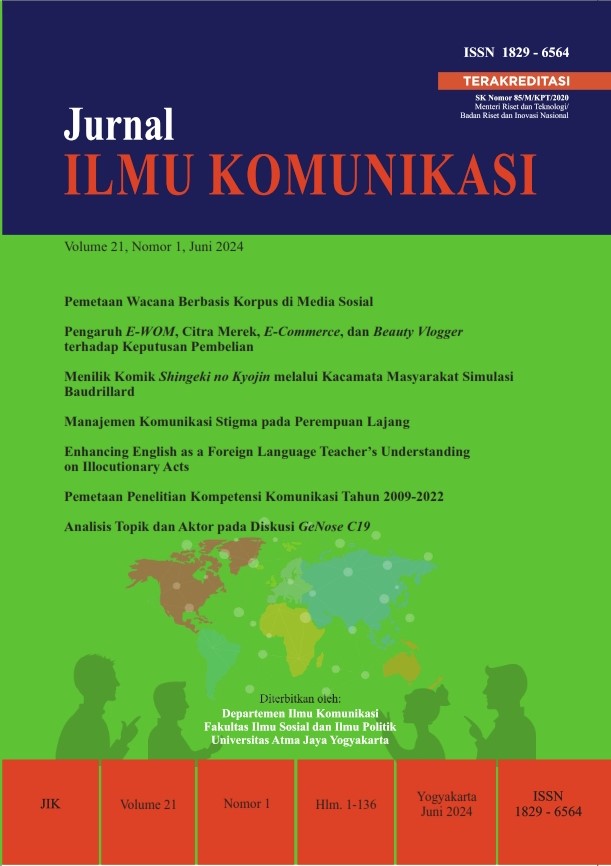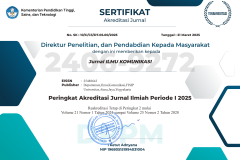Enhancing English as a Foreign Language Teacher's Understanding on Illocutionary Acts
DOI:
https://doi.org/10.24002/jik.v21i1.7207Keywords:
functions, illocutionary act, interaction, typeAbstract
This content analysis delves into the exploration of types and functions of illocutionary acts within a video podcast of Najwa Shihab. For the sake of a comprehensive analysis, rigorous transcription procedures were utilized. The result revealed that there were five illocutionary acts namely: 1) representative (21 items)—conveying information, 2) directive (39 items)—eliciting specific responses, 3) commissive (5 items)—indicating willingness or obligation, 4) expressive (4 items)—showing reactions, and 5) declarative (0 items). Thus, the types and functions of illocutionary acts have the potential to effectively and strategically interact with interlocutors. The study provides insight into managing interaction with students.
References
Aliakbari, M., & Bozorgmanesh, B. (2015). Assertive classroom management strategies and students’ performance : The case of EFL classroom. Cogent Education, 2(1) 1-12.
Bäckström, S. (2020). A dogma of speech act theory. Inquiry, 63, 1–17.
Bahing, Emzir, & Rafli, Z. (2018). English speech acts of illocutionary force in class interaction. Advances in Language and Literary Studies, 9(3), 113–119.
Barbieri, F. (2015). Involvement in university classroom discourse: Register variation and interactivity. Applied Linguistics, 36(2), 151–173.
Barraja-Rohan, A. M. (2011). Using conversation analysis in the second language classroom to teach interactional competence. Language Teaching Research, 15(4), 479–507.
Bolger, P. A., & Zapata, G. (2011). Semantic categories and context in L2 vocabulary Learning. Language Learning, 61(2), 614–646.
Cancino, M. (2015). Assessing learning opportunities in EFL classroom interaction: What can conversation analysis tell us? RELC Journal, 46(2), 115–129.
Carr, C. T., Schrock, D. B., & Dauterman, P. (2012). Speech acts within facebook status messages. Journal of Language and Social Psychology, 31(2), 176-196.
Chemmel, U., & Phillipe, R. (2018). The role of pragmatics in cross-cultural. Linguistics and Culture Review, 2(1), 45–59.
Chintawidy, P. A., & Sartini, N. W. (2022). A cross-cultural pragmatics study of request strategies and politeness in Javanese and Sundanese. Journal of Pragmatics Research, 4(1), 152–166.
Christison, M. (2018). Speech act theory and teaching speaking. The TESOL Encyclopedia of English Language Teaching, 1-6.
Couper, G., & Watkins, A. (2016). Teaching the sociocultural norms of an undergraduate community of practice. Tesol Journal, 7(1), 4-39.
Darong, H. C, Kadarisman, A. E., & Basthomi, Y. (2020). Teachers’ politeness markers in request in classroom interactions. NOBEL: Journal of Literature and Language Teaching, 11(2), 217–233.
Darong, H. C. (2020). Pragmatic strategy of indonesian english teachers in questioning. Journal of English Language Teaching and Linguistics, 5(2), 145-162.
------------------- (2021). Questioning practice in EFL classrrom interactions: from type to syntactical form. International Journal of Education and Learning, 3(2), 124–134.
-------------------. (2022). What does systemic functional linguistics say about speech? A discourse-semantic analysis. Journal of Russian Media and Journalism Studies, 4, 46–67.
Darong, H. C., & Guna, S. (2023). Corrective feedback: Pragmatic exposures in EFL classroom interactions. International Journal of Education and Learning, 5(1), 14–22.
Darong, H. C., & Neldis, N. (2023). Investigating illocutionary acts in video podcasts and its pedagogical implication in EFL teaching. Interdisciplinary Journal of Education Research, 5(June), 48–60.
Darong, H. C., Niman, E. M., Menggo, S., & Beda, R. (2021). Questioning practice and classroom interaction. Tell: Teaching of English Language and Literature Journal, 9(1), 11-24. https://doi.org/10.30651/tell.v9i1.5905
Derin, T., Nursafira, M. S., Yudar, R. S., Gowasa, N. S., & Hamuddin, B. (2020). Persuasive communication: What do existing literature tells us about persuasive communication among students? The Journal of Ultimate Research and Trends in Education, 2(1), 12–18.
Dresner, E., & Herring, S. C. (2010). Functions of the nonverbal in CMC: Emoticons and illocutionary force. Communication Theory, 20(3), 249–268.
Drew, C. (2017). Educational podcasts : A genre analysis. E-Learning and Digital Media, 14(4), 201–211.
Eshghinejad, S., & Moini, M. R. (2016). Politeness strategies used in text messaging: Pragmatic competence in an asymmetrical power relation of teacher– tudent. Sage Open, 6(1), 1-13.
Fetzer, A., & Bull, P. (2012). Doing leadership in political speech: Semantic processes and pragmatic inferences. Discourse & Society, 23(2), 127–144.
Firmansyah, L. V., & Arianti, T. (2022). Communication strategies used in EFL textbook in conversation models. International Journal of English Linguistics, Literature, and Education (IJELLE), 4(2), 100–114.
Fitriani, R. S., Hidayati, R, P. P., & Budiarti, A. (2021). Pragmatic markers and events on social media in new habit era of covid-19 outbreak. Linguistics and Culture Review, 5(S2), 1061–1071.
Gasparatou, R. (2016). Emotional speech acts and the educational perlocutions of speech. Journal of Philosophy of Education, 50(3), 319-331.
Gilson, C. M., Little, C. A., Ruegg, A. N., & Bruce-Davis, M. (2014). An investigation of elementary teachers’ use of follow-up questions for students at different reading levels. Journal of Advanced Academics, 25(2), 101–128.
Holmes, J. (2000). Politeness, power and provocation: How humor functions in the workplace. Discourse Studies, 2(2), 159–185.
Ingram, J., & Elliott, V. (2015). A critical analysis of the role of wait time in classroom interactions and the effects on student and teacher interactional behaviours. Cambridge Journal of Education, 46(1), 37–53.
Irwandika, G. (2021). A corpus study of commissive speech acts performed by USA presidential candidates. ELLITE: Journal of English Language, Literature, and Teaching, 6(1), 21–30.
Iv, H. R. M., & Tenore, F. B. (2010). Classroom management in diverse classrooms. Urban Education, 45(5), 560–603.
Kasim, F., Sumarlam, Suwandi, S., & Rakhmawati, A. (2017). A cross-cultural and intercultural of indirectness speect act: The use of interference local language in academic discourse at central of Sulawesi. International Journal of Pedagogy and Teacher Education (IJPTE), 1(2), 117–126.
Laeli, A. F., & Setiawan, S. (2019). Oral corrective feedback in speaking class: Its frequency, students’ perceptions and preference. Exposure: Jurnal Pendidikan Bahasa Inggris, 8(2), 257–269.
Limberg, H. (2015). Principles for pragmatics teaching: Apologies in the EFL classroom. ELT Journal, 69(3), 275–285.
--------------- (2016). Teaching how to apologize : EFL textbooks and pragmatic input. Language Teaching Research, 20(6), 700–718.
Lin, N., & Osnabrügge, M. (2018). Making comprehensible speeches when your constituents need it. Research and Politics, 5(3), 1–8.
Lindahl, K., & Watkins, N. M. (2015). Creating a culture of language awareness in content-based contexts. TESOL Journal, 6(4), 777–789.
Manzel, S. (2016). Competence for democracy: Participation and decision-making in classroom interaction. Citizenship, Social and Economics Education, 15(1), 15-27.
Meihami, H., & Khanlarzadeh, M. (2015). Pragmatic content in global and local ELT textbooks : A micro analysis study. SAGE Journal, 5(4), 1–10.
Nicholas, A. (2015). A concept-based approach to teaching speech acts in the EFL classroom. ELT Journal Volume, 69(4), 383–394.
Oktaviani, A. D., & Alam, O. S. N. (2022). Illocutionary speech acts and types of hate speech in comments on @ Indraakenz’s twitter account. International Journal of Science and Applied Science: Conference Series, 6(1), 91-99.
Prafitri, W., & Nasir, M. A. A. (2023). Persuasive strategies in Donald Trump’s political speeches. EBONY: Journal of English Language Teaching, Linguistics, and Literature, 3(1), 33–44.
Putra, I. P. W. A., & Sedeng, I. N. (2022). Directive illocutionary acts found in the movies 21 and 22 jump street. Humanis: Journal of Arts and Humanities, 26(2), 180–187.
Renisyifa, A., Sunarti, S., & Pebriyanti, A. (2022). Podcast media credibility as a means of fulfilling public information. International Journal of Research and Applied Technology, 2(1), 226–232.
Rimmer, W. (2016). The experience of initial management training in ELT. ELT Journal, 70(1), 78–87.
Rostiana, H., & Novari, A. F. (2021). A speech act analysis of an interview podcast between Siti Fadilah and Deddy Corbuzier on youtube. MENDIDIK: Jurnal Kajian Pendidikan Dan Pengajaran, 7(2), 189–195.
Schreier, M. (2012). Qualitative content analysis in practice. Thousand Oaks, CA: Sage Publications Inc.
Siegel, J. (2016). Pragmatic activities for the speaking classroom. English Teaching Forum, 54(1), 12-19.
Shihab, N. (2023, 12 April). Harta, tahta, dan kuasa: Bagaimana Islam mengajarkan untuk menikmatinya? Youtube.com. < https://www.youtube.com/watch?v=DeIPQ8E_ZnU>.
Siritman, B., Meilantina, M. (2020). English speech acts of directives in class interaction. International Journal of Language Education and Cultural Review(IJLECR), 6(1), 1–8.
Snead, L. O., & Freiberg, H. J. (2017). Rethinking student teacher feedback: Using a self-assessment resource with student teachers. Journal of Teacher Education, 7(2), 1–14.
Solem, M. S. (2016). Negotiating knowledge claims: Students’ assertions in classroom interactions. Discourse Studies, 18(6), 1-21. https://doi.org/10.1177/1461445616668072
Solem, M. S., & Skovholt, K. (2017). Teacher formulations in classroom interactions. Scandinavian Journal of Educational Research, 63(1), 1-20.
Taguchi, N. (2011). The effect of L2 proficiency and study-abroad experience on pragmatic comprehension. Language Learning, 61(3), 904–939. https://doi.org/10.1111/j.1467-9922.2011.00633.x
Taguchi, N., Xiao, F., & Li, S. (2016). Effects of intercultural competence and social contact on speech act production in a Chinese study abroad context. The Modern Language Journal, 100(4), 1–22. https://doi.org/10.1111/modl.12349
Tanduk, R. (2023). Pragmatic aspects of speech acts: A cross-linguistic perspective. English Review: Journal of English Education, 11(3), 881–890. https://doi.org/10.25134/erjee.v11i3.8762
Tromp, J., Hagoort, P., & Meyer, A. S. (2016). Pupillometry reveals increased pupil size during indirect request comprehension. The Quarterly Journal of Experimental Psychology, 69(6), 1093–1108.
Yazdanfar, S., & Bonyadi, A. (2016). Request strategies in everyday interactions of Persian and English speakers. SAGE Journals, 6(4), 1–11.
Zhu, W. (2012). Polite Requestive Strategies in Emails: An investigation of pragmatic competence of Chinese EFL learners. RELC Journal, 43(2), 217–238.
Zulkiana, K., Iskandar, & Abdullah. (2023). Illocutionary acts in F. Scott Fitzgerald’s short stories. ELITERATE :Journal of English Linguistics and Literature Studies, 3(2), 14–26. https://ojs.unm.ac.id/Eliterate/article/view/46381
Downloads
Published
How to Cite
Issue
Section
License

This work is licensed under a Creative Commons Attribution 4.0 International License.
Jurnal ILMU KOMUNIKASI is an academic journal. As such, it is dedicated to the open exchange of information. For this reason, JIK is freely available to individuals and institutions. Authors who publish in Jurnal ILMU KOMUNIKASI will release their articles under the Creative Commons Attribution (BY) License. This license allows anyone to copy and redistribute the article in any medium or format as well as remix, transform, and build upon the material for any purpose, even commercially as long as they credit the authors for the original creation. For details of the rights authors grants users of their work, see the "human-readable summary" of the license, with a link to the full license. (Note that "you" refers to a user, not an author, in the summary)
 This work is licensed under a Creative Commons Attribution 4.0 International License.
This work is licensed under a Creative Commons Attribution 4.0 International License.














